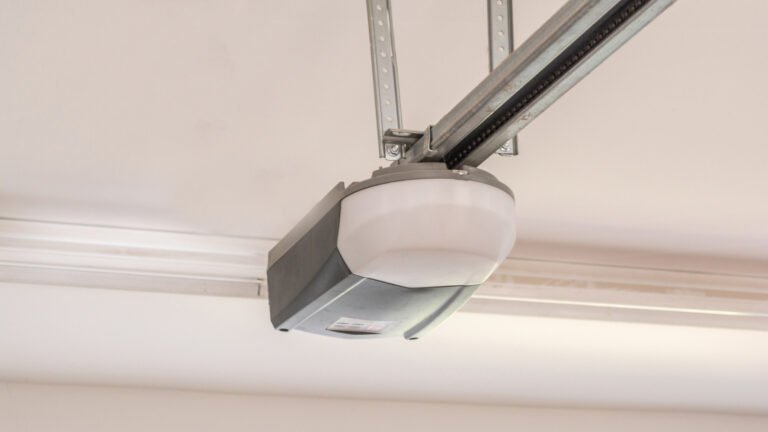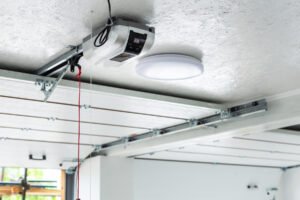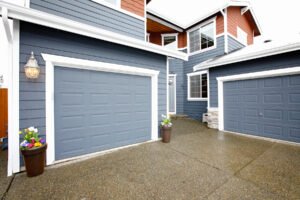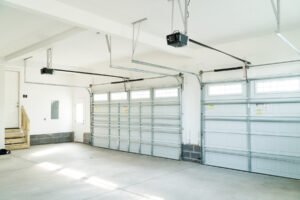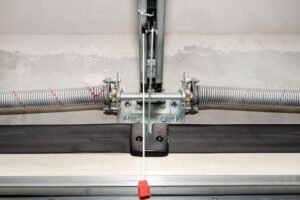Have you ever tried opening a garage door manually? It might seem easy to slide or roll the door along tracks, but it is pretty heavy in reality and might dent or tilt if not balanced. So, it’s best to get the right garage door opener to control your door opening easily and balance it with minimum energy.
But since different openers come with different horsepower, mechanisms, and modes of operation, finding the right fit for your garage door might be exhausting. But sit back and relax as we’ll guide you through.
To find the right type, it might be handy to know the pros, cons, and capacities before purchasing a new garage door opener for your door. So, we compared the cost and automation of different types of garage door openers to help you pick the best one. Let’s explore more.
How Does a Garage Door Opener Work?
Garage door openers have heavy-duty motor or double alkaline opener batteries and a small rotating arm that connects to the top of the garage door and operates it as required. The opener might have an additional belt, chain, or drive that runs the motor manually and closes the shutter in case of power failure.
Types of Garage Door Openers for Sturdier Operations
Different garage door opener types have different capacities, ac motors, rolling codes, safety conditions, and materials. Thus, they might not suit every type of garage door and might bang, warp or dent the door in case of faulty installation.
So, we compared the cost, lifespan, and type of each garage opener and compiled it below for your convenience.
1. Chain Drive Garage Door Opener
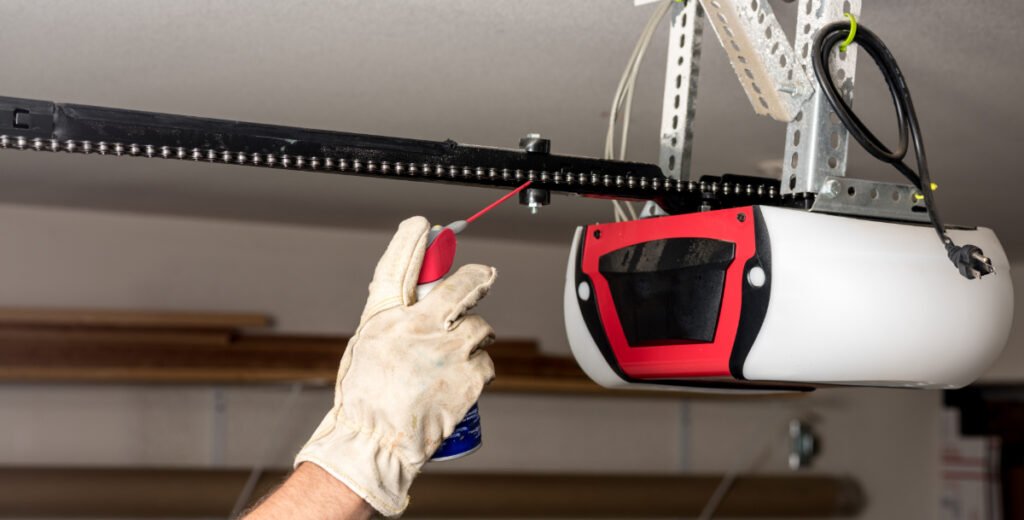
How Does It Work: A chain drive opener has a welded metal chain or cable that connects to the top of the door using a rotating J-arm or metal bar. The chain coils on the remote signal, pushes the bar, and opens the door.
Chain drive openers have simple metal chains that coil and uncoil to operate the door. Thus, they are sturdy, heavy, and have a superior capacity to lift heavier wooden or sectional doors. And these openers are not only affordable and durable but have a flexible chain that fits smaller, larger, or odd-shaped doors.
However, a chain drive opener is quite noisy and might transfer its heavy vibrations to surrounding walls and garage ceiling. Plus, it has a lot of levers and rotating bars, making it difficult for DIY installation.
It also requires lubrication and maintenance from time to time and might rust or weather due to moisture or chemicals.
Best Preferred For: Insulated doors, Sectional or Wooden Side-hinged doors, and Mission doors.
| Average Cost | $150 – 250 |
| Average Lifespan | 10 – 15 years |
| Standard Weight | 30 – 40 lbs |
Pros:
- Sturdier and Slip-resistant
- Durable and Long-lasting
- Easier to Repair or Replace
- Connects to Wifi and can be controlled with a smartphone easily
- Can lift heavier doors of 3 – 4 car garages
Cons:
- Noisy and Vibrating
- Older technology that might not suit modern canopy or retractable doors
- Not suitable for basement or attached garages
- Needs more maintenance and lubrication
Use a good-quality lubricating oil, lithium, white grease, WD-40 or lube and oil the chain, ball bearings and arm bars to reduce friction and enhance the durability.
2. Belt Drive Garage Door Opener
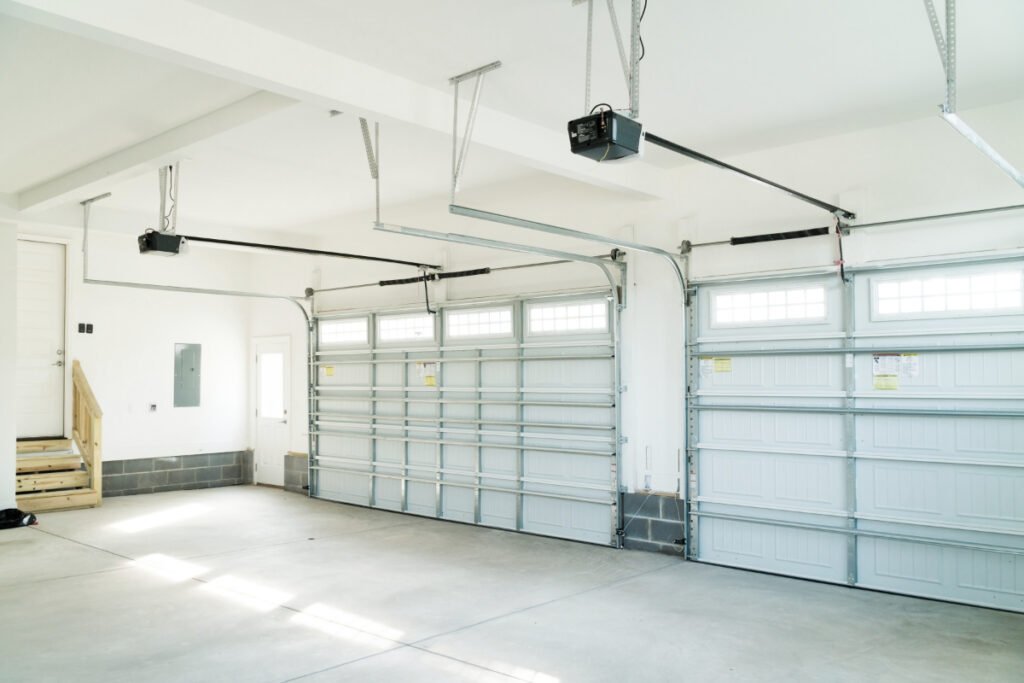
How Does It Work: A belt driven opener has a reinforced fiberglass, polyurethane, or steel belt that pulls or pushes a connecting trolley between the door and the opener arm to open or close the door as desired.
Belt drive openers have an elastic belt that expands and contracts to open the door. These openers have fewer moving parts that reduce friction and enhance durability. Thus, they are much faster, adjustable, noise-free, and adapt to both single and multi-panel doors.
However, these door openers are vulnerable to temperature fluctuations and might contract or freeze during winter. And they are not only expensive but also require frequent belt replacements for optimal function.
Furthermore, they have lesser capacities and cannot lift heavier retractable, side-hinged, or canopy doors. Nevertheless, a belt drive opener is the best choice for an apartment or attached garage and protects well from the overall sound and fire mishap.
Best Preferred For: Lightweight sectional doors, rolling doors, or any steel precision garage door.
| Average Cost | $200 – 350 |
| Average Lifespan | 10 – 12 years |
| Standard Weight | 25 – 40 lbs |
Pros:
- Sturdy and Noise-free
- Do not break, rust, or deform
- Less installation, maintenance, or repair charges
- Fast and Energy-efficient
Cons:
- High upfront cost or replacement bills
- Can slip and malfunction during winter
- Wear out and weather with continuous use
- Limited to one-car and two-car garages
Do NOT apply any lubricant, oil or grease to your belt drive opener as this may attract more dust to the roller tracks and disrupt the door operation.
3. Screw Drive Garage Door Opener
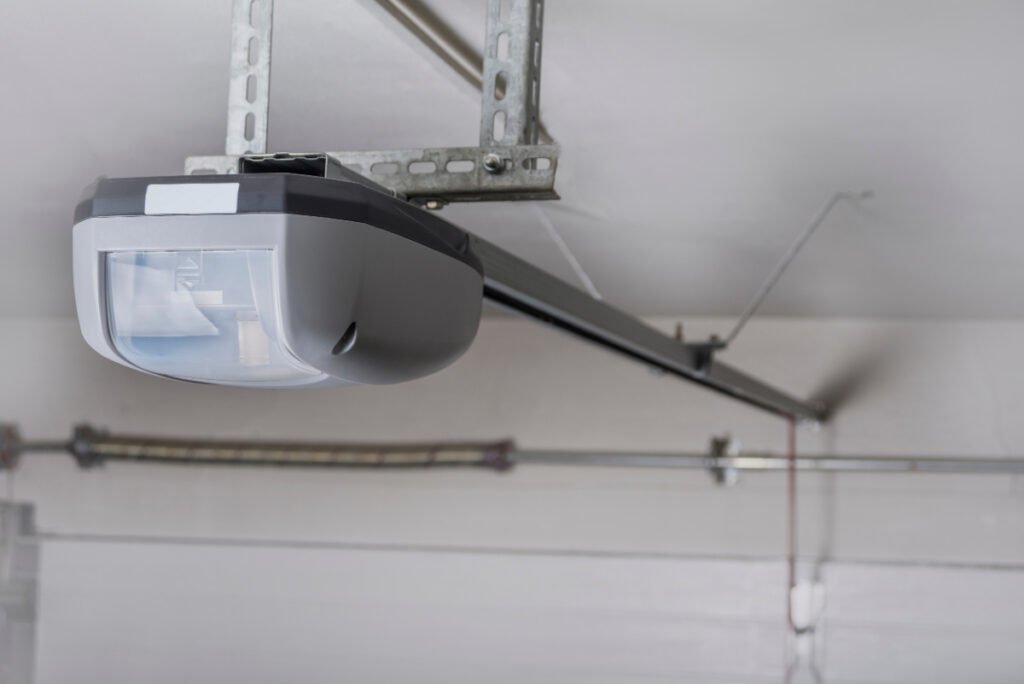
How Does It Work: A screw drive opener has a threaded steel rod that rotates on an electric motor, turns the door lever, and raises or lowers the shutter on clockwise and anticlockwise rotations, respectively.
Screw drive openers work on a pivoting screw that rotates, loosens the lever, and opens the door. These door openers might be slow but are smooth and compact. As such, they are ideal for flat, low-height garages with heavier doors.
Additionally, a screw-driven opener has a self-balancing mechanism that redistributes the weight of door panels, reduces the jerks and dents, and balances them evenly.
And though these do not break or slip frequently, they need regular oiling to reduce the friction between their metal parts and remain noise-free. Plus, these openers are expensive, challenging to repair or replace and might expand or contract with temperature fluctuations.
Best Preferred For: 3-car or 4-car residential garage door, Carriage or French doors, Panelled doors.
| Average Cost | $300 – 350 |
| Average Lifespan | 7 – 8 years |
| Standard Weight | 20 – 35 lbs |
Pros:
- Easy to Install and Fewer moving parts
- Balances the door evenly
- Ideal for large and heavier doors
- Compact yet efficient
Cons:
- Susceptible to temperature changes
- Noisy
- Need heavy maintenance and lubrication
- Expensive
Always clean, adjust and lubricate the threaded steel rod and screw with a cold weather lubricant or synthetic oil to prevent it from freezing in the winter. Similarly, polish the screw with anti-rust solutions to keep it corrosion-free during summers.
4. Jackshaft Garage Door Opener
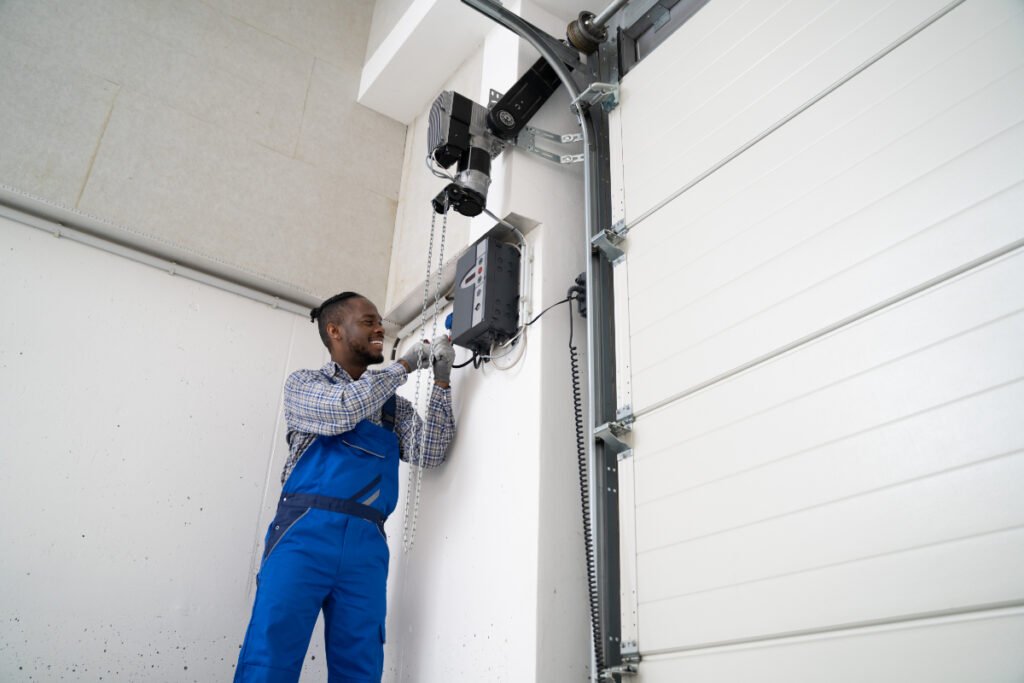
How Does It Work: A jackshaft opener is a wall mount, a motor-operated device with a heavy-duty, 24-v dc motor that pulls the drive and pulleys, raises the door panel, and opens it on remote command.
Jackshaft openers operate on a dc motor. Thus they need separate electric sources and conduits, which might lower your garage’s vertical height. But, these door openers are quite aesthetic and use a smart-phone friendly technology that makes them operable from a distance. Moreover, they are quiet, sturdy, and more aesthetic.
However, jackshaft openers are not that budget-friendly and require maintenance and oiling from time to time. They have tiny parts that cannot be DIY installed and need professional garage door service. Plus, this type of garage door opener is limited to new garage door models and cannot adapt to traditional, hinged ones.
Best Preferred For: Residential or commercial sectional doors or any overhead door.
| Average Cost | $500 – 650 |
| Average Lifespan | 15 – 20 years |
| Standard Weight | 25 – 30 lbs |
Pros:
- Smooth operations and noise-free
- Sturdy and increased safety
- Aesthetic and no hanging chains or belts
Cons:
- Need professional garage door opener installation
- Expensive
- Doesn’t adapt to traditional or hinged doors
- High energy costs
Install push down spring bumpers at the back of the connecting rod to prevent the garage door from banging and disturbing the opener’s parts. Additionally, you may install some garage door bottom seals for added protection.
5. Direct Drive Openers
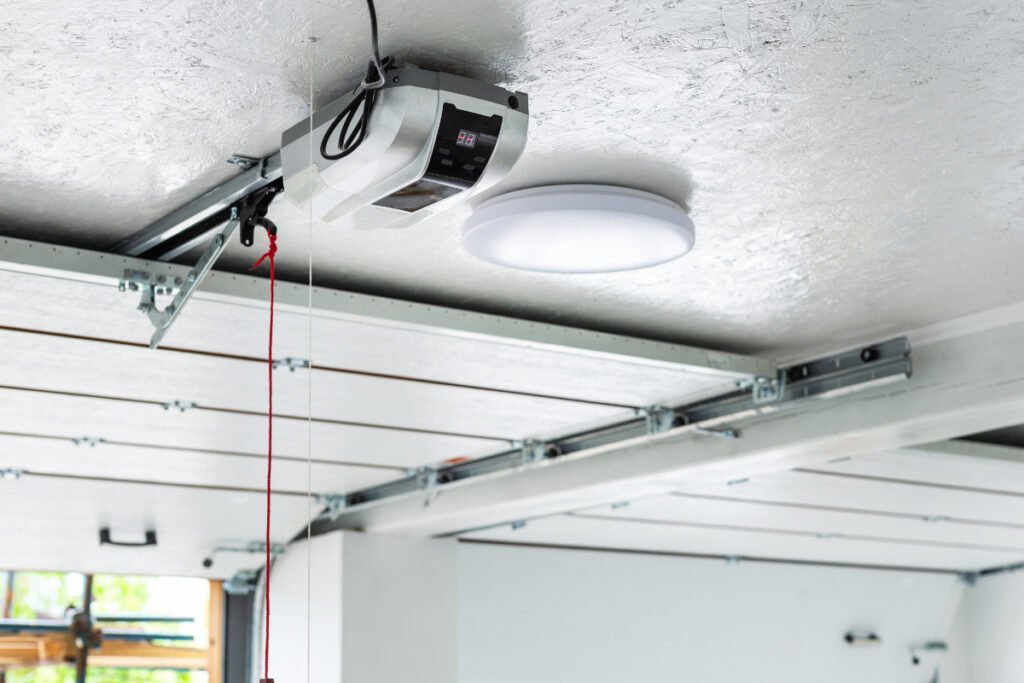
How Do They Work: Direct drive openers have a pivoting motor and gear trolley that moves along a stationary chain or belt track, pulls the connecting rod and opens the door slowly and steadily.
Direct drive openers are comparatively new and work on a rotating motor that reduces friction and overall wear and tear. They are heavy-duty openers and can operate larger 8-foot doors without any additional extension.
Plus, these openers are sturdy and secure and have an anti-reverse sensor that reverses the door direction whenever the tracks are blocked.
However, they are expensive and have a heavier, 1-horsepower motor that might hike your energy costs. This type of opener also incurs extra costs for installing and maintaining their external keypads, wall sensors, and infrared detectors. Overall, these are quite high-tech but offer complete control over larger RV or carport garage doors.
Best Preferred For: Taller RV garage doors, sectional doors, or rolling doors.
| Average Cost | $550 – 700 |
| Average Lifespan | 15 – 20 years |
| Standard Weight | 15 – 25 lbs |
Pros:
- Easy to Install, Repair, and Maintain
- Lifetime Warranty
- Sturdy and noise-free
- Boosts the resale value
- High strength and counterbalances the door weight
Cons:
- Expensive
- Additional costs for its parts and sensors
- May hike the energy bill
Never apply lithium lubes or grease with direct drive openers as these may attract dust and cause the opener to malfunction. Instead, use a dry lube or oil-penetrating lubricant for smooth rotations.
6. Automatic or Smart Garage Door Opener
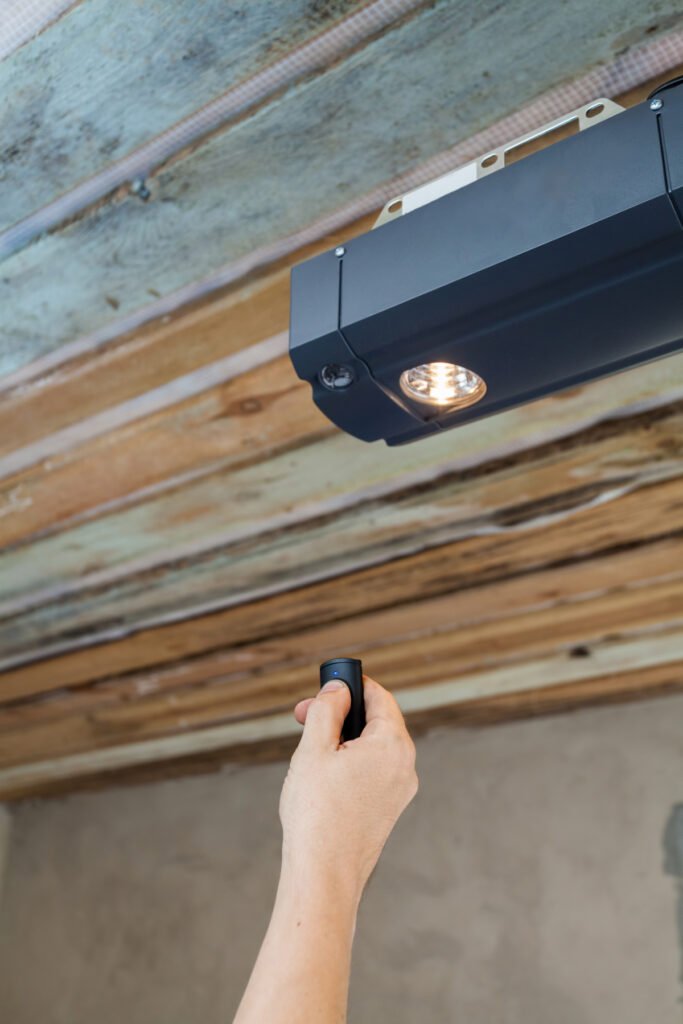
How Does It Work: Automatic garage door openers have a motor and a receiver that matches frequencies with the opener remote, triggers the sensors on the door, and operates them as desired.
Automatic openers are smart home integration systems that operate lightweight steel or metal doors through Wi-Fi. These are keyless and simultaneously work on a passcode system that ensures security and convenience. They have strong laser lights that clearly demarcate the parking bays and provide light within the garage.
And they send alerts and smartphone notifications on any door activity and help prevent burglary. They are also highly convenient, cost-effective, and lower energy use.
However, automatic garage door openers have a lot of small parts, wires, and chips and need frequent repairing and reprogramming from a garage door professional. Plus, they might stop working and get stuck in case of power outages and need a stronger battery backup.
Best Preferred For: Overhead, Rolling, Siding, and Sectional doors.
| Average Cost | $450 – 600 |
| Average Lifespan | 15 – 20 years |
| Standard Weight | 20 – 30 lbs |
Pros:
- Convenient and can be remotely operated
- Safe and easy to use
- Enhanced security and passcodes
- Low energy use and cost-efficient in the long run
Cons:
- Challenging to DIY install or repair
- Ceases and stops during electrical outage
- Incurs significant repair and maintenance costs
Automatic door openers should be serviced and reset once every 18 months to test their door balance and repair any minor flaws immediately.
Comparing Popular Garage Door Openers
| Parameter | Chain drive | Belt drive | Screw drive | Jackshaft | Direct drive | Automatic |
| Wi-fi connectivity | Yes | Yes | No | Yes | Yes | YesYe |
| Ease of installation | Difficult | Easy | Easy | Difficult | Easy | Difficult |
| Cost | Low | Moderate | High | High | High | High |
| Weight | Moderate | Light | Light | Light | Light | Moderate |
| Average battery life | 2 years | 50 cycles | 40 cycles | 1 – 2 years | 2 years | 2 years |
Benefits of a Garage Door Opener

Garage door openers are indeed necessary to save all the manual force required to operate the door. But do you know that it also helps enhance the security and insulation of your door?
Let’s find out some more added benefits of garage door openers and help you make a wise selection.
- Security: Garage door openers have a daily mode and a vacation mode that adds a double lock and a passcode to your door if you are away for a longer period.
- Lighting: Most garage door openers have a small navigation light that helps you find the switches at night and prevents any damage.
- Convenience: Garage door openers can be operated from a distance, and you don’t need to get out of your car to operate the door every time.
- Insulation: Most garage door openers have temperature control sensors that alert owners and prevent the garage from getting too hot or cold. Thus, they act as thermometers and prevent additional heating and cooling costs.
- Boosts Home Value: Garage door openers boost the home value by about 4-5%, depending on the style, and are certainly worth investing.
Tips for Choosing a Suitable Garage Door Opener
- Use ½ horsepower openers for single and double doors, ⅓ horsepower openers for lightweight steel doors, and heavy-duty ¾ horsepower openers for thicker wooden and sectional doors.
- Pick AC-powered motors for heavier, electrically operated doors while choosing DC motors for reversible, retractable doors or battery backups.
- Traditional drive openers are often limited to 6 and 7-feet doors. Hence, pick direct drive or automatic openers for taller, wider, or odd-sized doors.
- Use 3 or 4-button garage door openers to operate more doors using a single opener modem.
- You can use any type of openers with a detached garage, but select noise-free direct drive and jackshaft openers for an attached garage.
How Much Horsepower Do I Need for My Garage Door Opener?
Garage door openers usually operate on ½ to ⅓ horsepower for residential doors, but you might need ¾ horsepower for heavier, sectional doors, weighing about 500 – 600lbs.
What Is the Quietest Garage Door Opener?
Belt driver openers are quieter and do not have any smaller metal parts or chains that create friction and cause a noisy operation. Instead, they have rubber belts that rotate smoothly without any turbulence.
How Long Does It Take to Install a Garage Door Opener?
Garage door opener installation typically takes about 4-5 hours for professionals and might take a whole day if you plan to DIY.
Garage door openers are essential to balance your door and lift it easily without any manual force. These machines may have additional guiding lights, buttons, and automation facilities that make your job even easier. Generally, sturdier drive openers are best for heavier doors in detached garages, while automatic ones are for lighter, attached garage doors.
Garage door openers usually last 15-20 years but can be modified and reprogrammed to minimize the repairs and damage. So, don’t forget to check our related article on ‘ How long do garage door openers last and how to increase their lifespan’ to know more.

